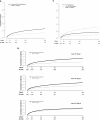Predictors of Recurrent AKI
- PMID: 26264853
- PMCID: PMC4814177
- DOI: 10.1681/ASN.2014121218
Predictors of Recurrent AKI
Abstract
Recurrent AKI is common among patients after hospitalized AKI and is associated with progressive CKD. In this study, we identified clinical risk factors for recurrent AKI present during index AKI hospitalizations that occurred between 2003 and 2010 using a regional Veterans Administration database in the United States. AKI was defined as a 0.3 mg/dl or 50% increase from a baseline creatinine measure. The primary outcome was hospitalization with recurrent AKI within 12 months of discharge from the index hospitalization. Time to recurrent AKI was examined using Cox regression analysis, and sensitivity analyses were performed using a competing risk approach. Among 11,683 qualifying AKI hospitalizations, 2954 patients (25%) were hospitalized with recurrent AKI within 12 months of discharge. Median time to recurrent AKI within 12 months was 64 (interquartile range 19-167) days. In addition to known demographic and comorbid risk factors for AKI, patients with longer AKI duration and those whose discharge diagnosis at index AKI hospitalization included congestive heart failure (primary diagnosis), decompensated advanced liver disease, cancer with or without chemotherapy, acute coronary syndrome, or volume depletion, were at highest risk for being hospitalized with recurrent AKI. Risk factors identified were similar when a competing risk model for death was applied. In conclusion, several inpatient conditions associated with AKI may increase the risk for recurrent AKI. These findings should facilitate risk stratification, guide appropriate patient referral after AKI, and help generate potential risk reduction strategies. Efforts to identify modifiable factors to prevent recurrent AKI in these patients are warranted.
Keywords: acute renal failure; clinical epidemiology; outcomes.
Copyright © 2016 by the American Society of Nephrology.
Figures




References
-
- Xue JL, Daniels F, Star RA, Kimmel PL, Eggers PW, Molitoris BA, Himmelfarb J, Collins AJ: Incidence and mortality of acute renal failure in Medicare beneficiaries, 1992 to 2001. J Am Soc Nephrol 17: 1135–1142, 2006 - PubMed
-
- (USRDS) USRDS : Annual Data Report 2013, Chapter 6, Acute Kidney Injury, 2013
Publication types
MeSH terms
Grants and funding
- K23-DK090304/DK/NIDDK NIH HHS/United States
- K23-DK088964-03/DK/NIDDK NIH HHS/United States
- K23-DK088865/DK/NIDDK NIH HHS/United States
- T32 DK007569/DK/NIDDK NIH HHS/United States
- 5T32-DK007569-25/DK/NIDDK NIH HHS/United States
- I01 HX001280/HX/HSRD VA/United States
- K23 DK088964/DK/NIDDK NIH HHS/United States
- K24-DK62849/DK/NIDDK NIH HHS/United States
- K24 DK062849/DK/NIDDK NIH HHS/United States
- U01 DK082192/DK/NIDDK NIH HHS/United States
- K23 DK088865/DK/NIDDK NIH HHS/United States
- I01 CX000982/CX/CSRD VA/United States
- IIR 13-073/HX/HSRD VA/United States
- 5U01DK92192-07/DK/NIDDK NIH HHS/United States
- K23 DK090304/DK/NIDDK NIH HHS/United States
LinkOut - more resources
Full Text Sources
Other Literature Sources

